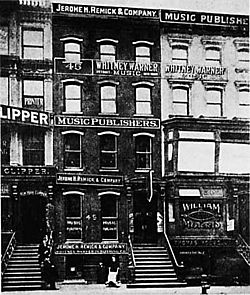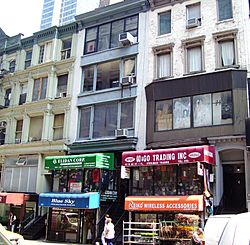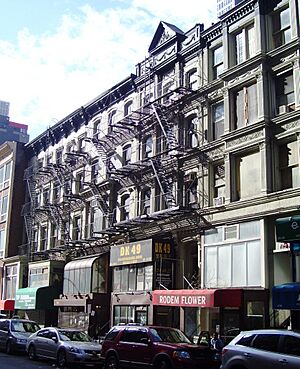Tin Pan Alley facts for kids
Tin Pan Alley was a special place in New York City. It was home to many music publishers and songwriters. These companies and artists created most of the popular music in the United States. This happened from the late 1800s to the early 1900s.
The name "Tin Pan Alley" first referred to a street. This was West 28th Street in Manhattan. It was between Fifth and Sixth Avenues. Today, a special plaque on 28th Street remembers this history. Some buildings there are even protected as landmarks. The street section itself is now officially called Tin Pan Alley.
Tin Pan Alley began around 1885. That's when many music publishers opened offices in this area. When it ended is less clear. Some say it was in the 1930s. This was when phonographs, radio, and movies became popular. They took over from sheet music as the main way people heard music. Others believe Tin Pan Alley continued into the 1950s. This was before Rock and roll became huge. Rock and roll music was often created in the Brill Building.
Contents
- What Does "Tin Pan Alley" Mean?
- How Music Publishing Started in New York City
- New York City's Music Scene Before Tin Pan Alley
- Tin Pan Alley's Busy Days
- How Tin Pan Alley Changed Laws and Business
- Music During World War II
- Famous Songwriters and Composers
- Popular Songs from Tin Pan Alley
- Tin Pan Alley's Lasting Impact
- See also
What Does "Tin Pan Alley" Mean?
There are different ideas about where the name "Tin Pan Alley" came from. The most common story is that it described the sound of many pianos. These were often "cheap upright pianos" all playing different songs. The sound was like banging on tin pans in an alley. A writer named Monroe H. Rosenfeld might have used this phrase first in 1903.
Another story involves songwriter Harry von Tilzer. He was interviewed about the music area. Von Tilzer had changed his piano to make a more drumming sound. The journalist told him, "Your Kindler & Collins sounds exactly like a tin can." The journalist then said, "I'll call the article 'Tin Pan Alley'." By 1908, the name was widely used.
Over time, "Tin Pan Alley" became a general term. It described the entire American music publishing industry. The name also spread to the United Kingdom. There, Denmark Street in London was called "Britain's Tin Pan Alley." This was because of its many music shops in the 1920s.
How Music Publishing Started in New York City
In the mid-1800s, copyright laws for music were not very strong. Publishers often printed their own versions of popular songs. Later, stronger copyright laws helped songwriters and publishers work together. This helped them all earn money.
The center of music publishing moved over time. It started in Boston, then went to other cities. Finally, it settled in New York City. New publishers focused on songs people could sing. Two important New York publishers were Willis Woodard and T.B. Harms. They were among the first to focus on popular songs. Before them, most companies printed hymns or classical music.
These early music companies were in the entertainment area. This was around Union Square. As the entertainment area moved uptown, so did the music publishers. Witmark was the first to move to West 28th Street. By the late 1890s, most publishers had followed.
Big music companies were in New York City. But smaller publishers were all over the country. Important music centers were also in Chicago, New Orleans, and St. Louis. If a song became a hit in a local area, a big New York company would often buy the rights to it.
New York City's Music Scene Before Tin Pan Alley
Before Tin Pan Alley, American music publishing often used European songs. This was to avoid paying copyright fees. Making American music was expensive in the 1800s. Only about 10-30% of the music printed in the U.S. was by American composers. However, this early industry helped set up the way Tin Pan Alley would work.
In the 1860s, a musician named J.N. Pattison published sheet music. He sold it from a piano and organ store. He was one of the few musicians to publish his own music. This was during a time when sheet music sales were growing fast. Many middle-class families owned a piano. If they wanted to hear a new song, they would buy the sheet music. Then they could play it at home.
Tin Pan Alley's Busy Days
The people who started Tin Pan Alley music companies often had sales backgrounds. For example, Isadore Witmark used to sell water filters. Leo Feist sold corsets.
The music offices in New York were very lively places. Songwriters, vaudeville performers, musicians, and "song pluggers" were always coming and going.
- Songwriters: People who wrote songs came to show their tunes. They hoped to sell them. If a song was bought from a new writer, the company might add one of their own names as a co-writer. This kept more money in the company. Sometimes, they just bought all rights to the song for a one-time payment. Many Jewish immigrants became music publishers and songwriters there. Famous songwriters like Irving Berlin and George M. Cohan worked in Tin Pan Alley.
- Song Pluggers: These were pianists and singers. They worked for music publishers. Their job was to play and sing new songs to help sell sheet music. Most music stores had song pluggers. Some pluggers traveled to introduce new songs to the public. Famous pluggers included George Gershwin and Harry Warren. A more active way of plugging was called "booming." This meant buying many tickets to shows. Then, the pluggers would sing the song to the audience. One publisher recalled singing a song 30 times a night at cycle races. People would leave singing the song.
Vaudeville performers often visited Tin Pan Alley. They looked for new songs for their shows. Less famous performers paid to use new songs. But famous stars got free copies. Publishers even paid them to perform the songs. They knew this was great advertising.
At first, Tin Pan Alley focused on emotional songs and funny songs. But it quickly started using new styles. These included the cakewalk and ragtime music. Later, jazz and blues were also included. Tin Pan Alley wanted to create songs that amateur singers or small bands could play from sheet music. In the 1910s and 1920s, it published pop songs and dance tunes in jazz and blues styles.
Tin Pan Alley also brought new ideas to music. It used sounds from African-American music like ragtime and blues. It also took ideas from other types of music. These new styles helped Tin Pan Alley grow. They allowed composers to be more creative.
How Tin Pan Alley Changed Laws and Business
A group of Tin Pan Alley music companies formed the Music Publishers Association in 1895. They tried to change copyright laws. They wanted copyrights for music to last longer.
The American Society of Composers, Authors, and Publishers (ASCAP) was started in 1914. Its goal was to help and protect publishers and composers. New members could only join if existing members sponsored them.
The way Tin Pan Alley did business lasted for a long time. Even into the 1960s, its methods were still common. But then artists like Bob Dylan changed things. In 1985, Dylan said, "Tin Pan Alley is gone. I put an end to it. People can record their own songs now." This meant artists had more control over their music.
Music During World War II
During World War II, Tin Pan Alley and the U.S. government worked together. They wanted to create a war song. This song would inspire Americans to support the war. The government believed Tin Pan Alley had "talent and competence." They thought it could influence people's feelings. They hoped for a song as popular as "Over There" from World War I.
Some people in Congress argued about letting musicians avoid the draft. They wanted entertainers to stay home to boost morale. But others felt only those making bigger contributions should be exempt.
As the war went on, it became clear what the public wanted. People wanted music that helped them escape from the war's worries. Tin Pan Alley composers found it hard to write a war song that appealed to everyone. By the end of the war, no song became as famous as "Over There."
It's still debated how many war-related songs Tin Pan Alley released during World War II. Some say there were more songs in World War I. Others argue that World War II had the most war-related songs ever.
Famous Songwriters and Composers
Many talented people worked in Tin Pan Alley. Here are some of the composers and lyricists:
- Milton Ager
- Thomas S. Allen
- Harold Arlen
- Ernest Ball
- Harry Barris
- Irving Berlin
- Bernard Bierman
- George Botsford
- Shelton Brooks
- Lew Brown
- Nacio Herb Brown
- Irving Caesar
- Sammy Cahn
- Hoagy Carmichael
- George M. Cohan
- Con Conrad
- J. Fred Coots
- Gussie Lord Davis
- Buddy DeSylva
- Walter Donaldson
- Paul Dresser
- Dave Dreyer
- Al Dubin
- Vernon Duke
- Dorothy Fields
- Ted Fio Rito
- Max Freedman
- Cliff Friend
- T. Mayo Geary
- George Gershwin
- Ira Gershwin
- Albert Gumble
- Oscar Hammerstein II
- E. Y. "Yip" Harburg
- Charles K. Harris
- Lorenz Hart
- Silvio Hein
- Ray Henderson
- Ben Jerome
- William Jerome
- James P. Johnson
- Isham Jones
- Scott Joplin
- Gus Kahn
- Bert Kalmar
- Jerome Kern
- Ted Koehler
- Al Lewis
- Sam M. Lewis
- Frank Loesser
- Jimmy McHugh
- F. W. Meacham
- Johnny Mercer
- Halsey K. Mohr
- Theodora Morse
- Owen Murphy
- Ethelbert Nevin
- Mitchell Parish
- Bernice Petkere
- Maceo Pinkard
- Lew Pollack
- Cole Porter
- William Raskin
- J. A. Raynes
- Andy Razaf
- Richard Rodgers
- Harry Ruby
- Jean Schwartz
- Al Sherman
- Abner Silver
- Lou Singer
- Sunny Skylar
- Lee Orean Smith
- Ted Snyder
- Kay Swift
- Edward Teschemacher
- Albert Von Tilzer
- Harry Von Tilzer
- Fats Waller
- Harry Warren
- Paul West
- Richard A. Whiting
- Harry M. Woods
- Allie Wrubel
- Jack Yellen
- Vincent Youmans
- Joe Young
- Hy Zaret
Popular Songs from Tin Pan Alley
Tin Pan Alley created many hit songs. Here are some of the most famous ones:
- "A Bird in a Gilded Cage" (1900) – by Harry Von Tilzer
- "After the Ball" (1892) – by Charles K. Harris
- "Ain't She Sweet" (1927) – by Jack Yellen and Milton Ager
- "Alabama Jubilee" (1915) – by Jack Yellen and George L. Cobb
- "Alexander's Ragtime Band" (1911) – by Irving Berlin
- "All Alone" (1924) – by Irving Berlin
- "At a Georgia Campmeeting" (1897) – by Kerry Mills
- "Baby Face" (1926) – by Benny Davis and Harry Akst
- "Bill Bailey, Won't You Please Come Home" (1902) – by Huey Cannon
- "By the Light of the Silvery Moon" (1909) – by Gus Edwards and Edward Madden
- "Carolina in the Morning" (1922) – by Gus Kahn and Walter Donaldson
- "Come Josephine in My Flying Machine" (1910) – by Fred Fisher and Alfred Bryan
- "Down by the Old Mill Stream" (1910) – by Tell Taylor
- "Everybody Loves My Baby" (1924) – by Spencer Williams
- "For Sentimental Reasons" (1936) – by Al Sherman, Abner Silver and Edward Heyman
- "Give My Regards to Broadway" (1904) – by George M. Cohan
- "God Bless America" (1918; revised 1938) – by Irving Berlin
- "Happy Days Are Here Again" (1930) – by Jack Yellen and Milton Ager
- "Hearts and Flowers" (1899) – by Theodore Moses Tobani
- "Hello Ma Baby (Hello Ma Ragtime Gal)" (1899) – by Emerson, Howard and Sterling
- "Honeysuckle Rose" (1929) – by Andy Razaf and Thomas "Fats" Waller
- "I Cried for You" (1923) – by Arthur Freed and Nacio Herb Brown
- "I'm Forever Blowing Bubbles" (1919) – by John Kellette
- "In the Baggage Coach Ahead" (1896) – by Gussie L. Davis
- "In the Good Old Summer Time" (1902) – by Ren Shields and George Evans
- "In the Shade of the Old Apple Tree" (1905) – by Harry Williams and Egbert van Alstyne
- "K-K-K-Katy" (1918) – by Geoffrey O'Hara
- "Let Me Call You Sweetheart" (1910) – by Beth Slater Whitson and Leo Friedman
- "Lindbergh (The Eagle of the U.S.A.)" (1927) – by Al Sherman and Howard Johnson
- "Lovesick Blues" (1922) – by Cliff Friend and Irving Mills
- "Mighty Lak' a Rose" (1901) – by Ethelbert Nevin and Frank L. Stanton
- "Mister Johnson, Turn Me Loose" (1896) – by Ben Harney
- "My Blue Heaven" (1927) – by Walter Donaldson and George Whiting
- "Now's the Time to Fall in Love" (1931) – by Al Sherman and Al Lewis
- "Oh, Donna Clara" (1928) – by Irving Caesar
- "Oh by Jingo!" (1919) – by Albert Von Tilzer
- "On the Banks of the Wabash, Far Away" (1897) – by Paul Dresser
- "Over There" (1917) – by George M. Cohan
- "Peg o' My Heart" (1913) – by Fred Fisher and Alfred Bryan
- "Shine Little Glow Worm" (1907) – by Paul Lincke and Lilla Cayley Robinson
- "Shine on Harvest Moon" (1908) – by Nora Bayes and Jack Norworth
- "Some of These Days" (1911) – by Shelton Brooks
- "Stardust" (1927) – by Hoagy Carmichael and Mitchell Parish
- "Swanee" (1919) – by George Gershwin
- "Sweet Georgia Brown" (1925) – by Maceo Pinkard
- "Take Me Out to the Ball Game" (1908) – by Albert Von Tilzer
- "The Band Played On" (1895) – by Charles B. Ward and John F. Palmer
- "The Darktown Strutters' Ball" (1917) – by Shelton Brooks
- "The Little Lost Child" (1894) – by Marks and Stern
- "The Man Who Broke the Bank at Monte Carlo" (1892) – by Charles Coborn
- "The Sidewalks of New York" (1894) – by Lawlor and Blake
- "The Japanese Sandman" (1920) – by Richard A. Whiting and Raymond B. Egan
- "There'll Be a Hot Time in the Old Town Tonight" (1896) – by Joe Hayden and Theodore Mertz
- "Warmest Baby in the Bunch" (1896) – by George M. Cohan
- "Way Down Yonder in New Orleans" (1922) – by Creamer and Turner Layton
- "Whispering" (1920) – by Malvin Schonberger and John Schonberger
- "Yes, We Have No Bananas" (1923) – by Frank Silver and Irving Cohn
- "You Gotta Be a Football Hero" (1933) – by Al Sherman, Buddy Fields and Al Lewis
Tin Pan Alley's Lasting Impact
Protecting Historic Buildings
In 2019, the New York City Landmarks Preservation Commission decided to protect some buildings on West 28th Street. Five buildings (47–55 West 28th Street) were named individual landmarks. This happened after a group called "Save Tin Pan Alley" worked hard to protect them. After this success, a new group formed: the Tin Pan Alley American Popular Music Project.
On April 2, 2022, 28th Street between Broadway and 6th Avenue got a special co-name. It is now officially called "Tin Pan Alley" by New York City.
Tin Pan Alley in Pop Culture
- The blues song "Tin Pan Alley (AKA The Roughest Place in Town)" was a hit in 1953. It was sung by Jimmy Wilson. This song became very popular among blues performers. Stevie Ray Vaughan loved this song and covered it many times.
- A bar in Times Square was named Tin Pan Alley in the 1970s and early 1980s. This bar and its owners inspired the HBO series The Deuce. In the show, the bar was called The Hi-Hat.
- The song "Who Are You" by The Who mentions "Tin Pan." This refers to a long legal meeting with a music publisher.
- The Dire Straits song "It Never Rains" talks about a woman in the entertainment business. It mentions her being taken advantage of in 'Vaudeville Valley' and Tin Pan Alley.
See also
 In Spanish: Tin Pan Alley para niños
In Spanish: Tin Pan Alley para niños
- Music Row
- Printer's Alley
- Radio Row
- The Tin Pan Alley Rag
- Great American Songbook




